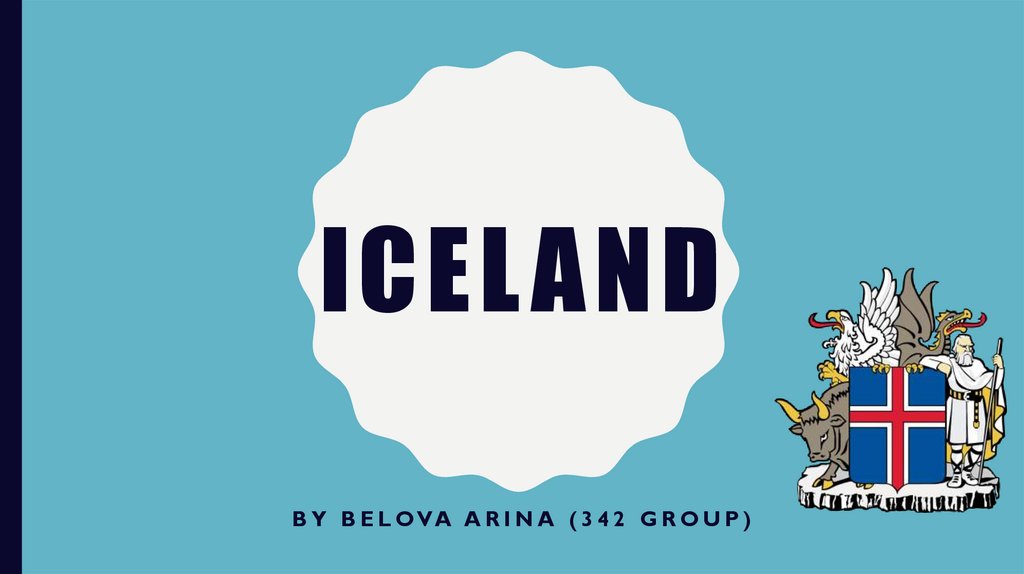Similar presentations:
Iceland. Geography of Iceland
1. Iceland
ICEL ANDB Y B E L OVA A R I N A ( 3 4 2 G R O U P )
2. Geography of Iceland
GEOGRAPHY OF ICELAND• Iceland, officially called the Republic of Iceland, is
an island nation located in the North Atlantic
Ocean just south of the Arctic Circle.
A large part of Iceland is covered with glaciers and snowfields
and most of the country's inhabitants live in the coastal areas
because those are the most fertile regions on the island.
3. Fast Facts
FAST FACTS• Official Name: Republic of Iceland
• Capital: Reykjavik
• Population:343 518 (2018)
• Official Languages: Icelandic, English, Nordic languages,
German
• Currency: Icelandic kronur (ISK)
• Form of Government: Unitary parliamentary republic
• Climate: Temperate; moderated by North Atlantic
Current; mild, windy winters; damp, cool summers
• Total Area: 39,768 square miles (103,000 square
kilometers)
• Highest Point: Hvannadalshnukur (at Vatnajokull
Glacier) at 6,923 feet (2,110 meters)
• Lowest Point: Atlantic Ocean at 0 feet (0 meters)
4. Culture
CULTURE• First of all, the culture of Iceland was formed under the
influence of the extremely harsh nature of this region, because
for almost the entire history of these lands, few people
claimed.
So, in Iceland, the features of peoples living in the Far North
prevail , but their culture simply glows with friendliness.
Just enjoy the nature of Iceland…
5. Religion Of Iceland
RELIGION OF ICELAND• Taking into account some
distance from the main
European continent and due to
the predominance in the history
of the traditions of the ancient
Vikings, the religion of Iceland
has preserved the main features
of pagan beliefs of ancient
ancestors.
Today, there is almost one Evangelical
Lutheran Church in Iceland , which is
92.2% of the total population of the
island.
6. Food
FOODThe writer Halldor Laxness once observed that "life is salt fish." During some of the events inspired by the
romantic folkloric revival, people consume brennivín, an alcoholic beverage called "black death," along with
fermented shark meat and smoked lamb, which is served at festive occasions. Icelanders are famous for the
amount of coffee they drink and the amount of sugar they consume.
brennivín
fermented shark
smoked lamb
7. Traditions Of Iceland
TRADITIONS OF ICELANDNames in Iceland
• The country has preserved the
custom of giving the newborn the
name of the father instead of the
surname, which leads to the
absence of a single surname in one
family. Names and surnames of
Icelanders are a nightmare for
international communication, which
leads to confusion in the
alphabetical index, and the name of
a person's profession can come to
the rescue.
8. Traditional Icelandic houses
TRADITIONAL ICELANDIC HOUSES• Vikings built houses from peat blocks with a wooden roof with one large room , this is convenient for
keeping warm during the winter, you need to heat one room. Stone houses in Iceland began to appear
from the 18th century , in the 19th century there were also two or even three- story buildings ,
traditionally such houses were made of imported wood, so there was no one on the island, tuff and
stones were also used, and all this was covered with iron on the outside
9. National clothes
NATIONAL CLOTHESThe national costume of Fjoudbuningurinn
has changed greatly over the past 800 years.
For women, there are several types of
national costumes: faldbuningyur, kirtil,
peysufet, upplutur, a little less options for
men, the main one is Fioudbuningyur kadla,
which consists of a jacket and woolen
trousers. Only in the 20th century appeared
the so-called Icelandic sweater Lopapeysa,
which is easily recognized around the world
and copies the style of dresses from
Greenland. The sweater appeared as a result
of the displacement of the national light
industry in Iceland, so that at least
somewhere to use sheep wool for its
intended purpose.
10. What do Icelanders do at home
WHAT DO ICELANDERS DO AT HOME• The main hobby in Iceland is knitting, and this is an opportunity to combine business with pleasure, how else to pass
the time of endless winter evenings, in addition, your own knitted sweater will be much warmer than the one that is
sold in shopping centers. Knitting in Iceland is not only for women, but also for men. This is probably the second
most popular occupation in the country after fishing and fish processing. Probably, the inhabitants of Reykjavik have
already lost the desire to knit, replacing it with the Internet, but on farms, women never let go of knitting needles.
Local handmade sweaters are very biting, so they have their nickname Stingubolur, but this is why they become warm,
because real heat should sting a little.











 geography
geography








